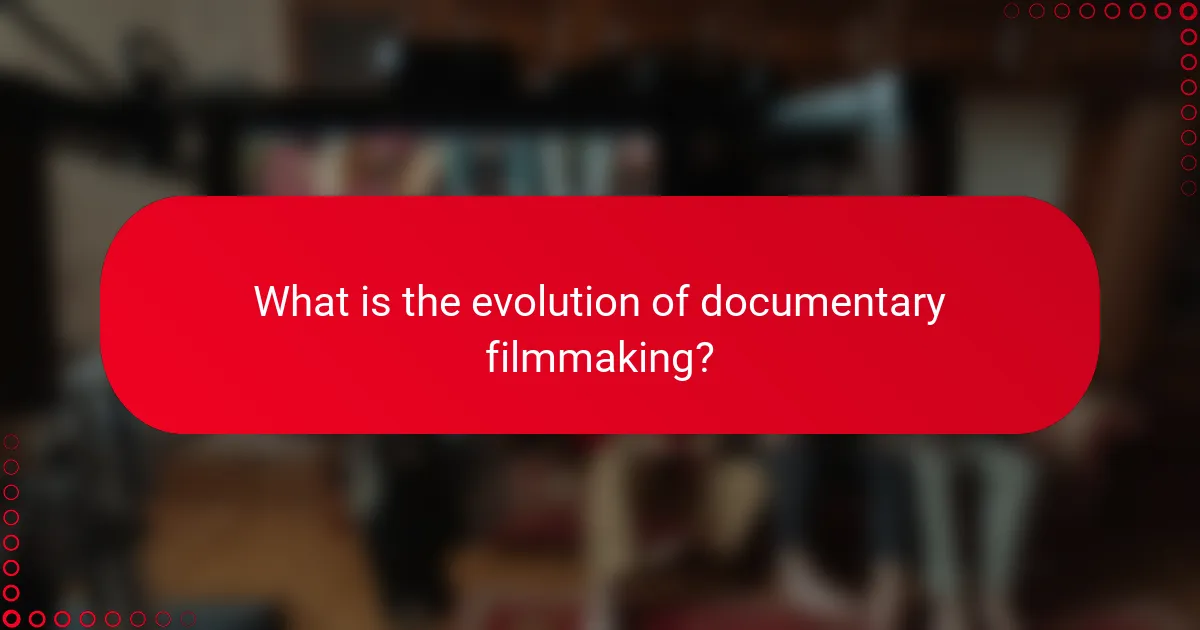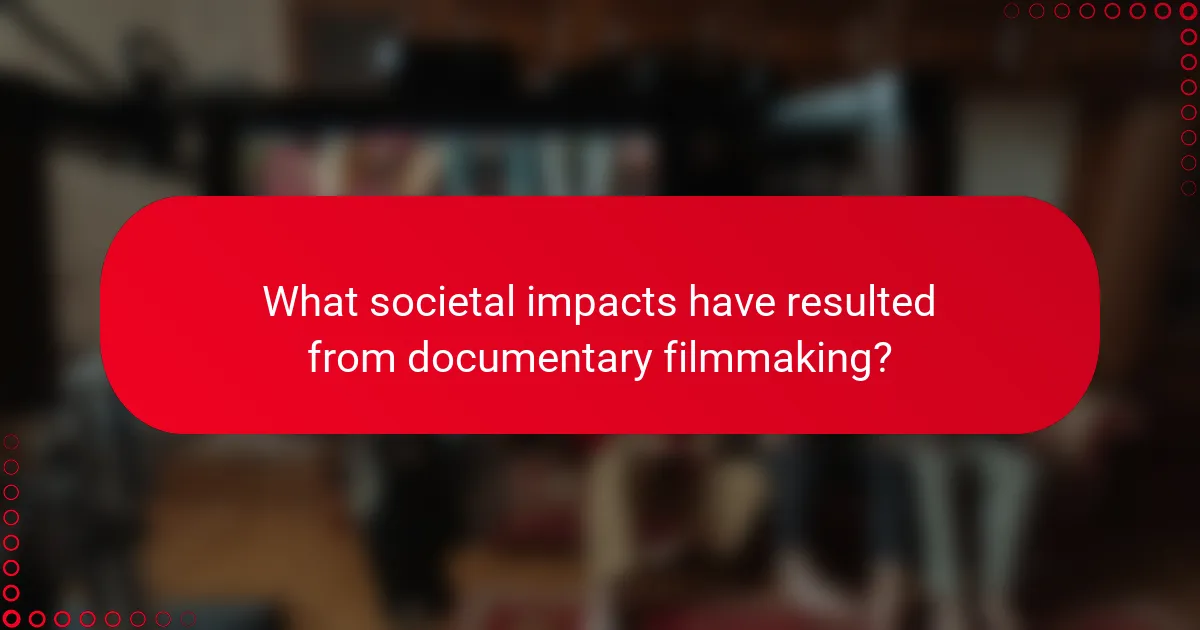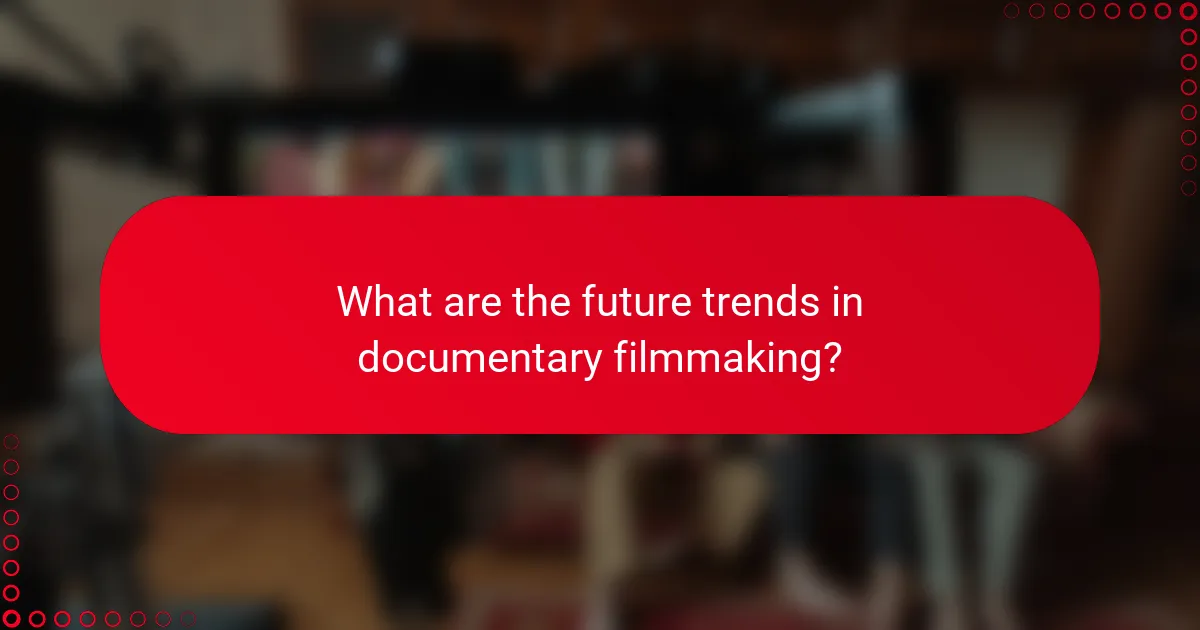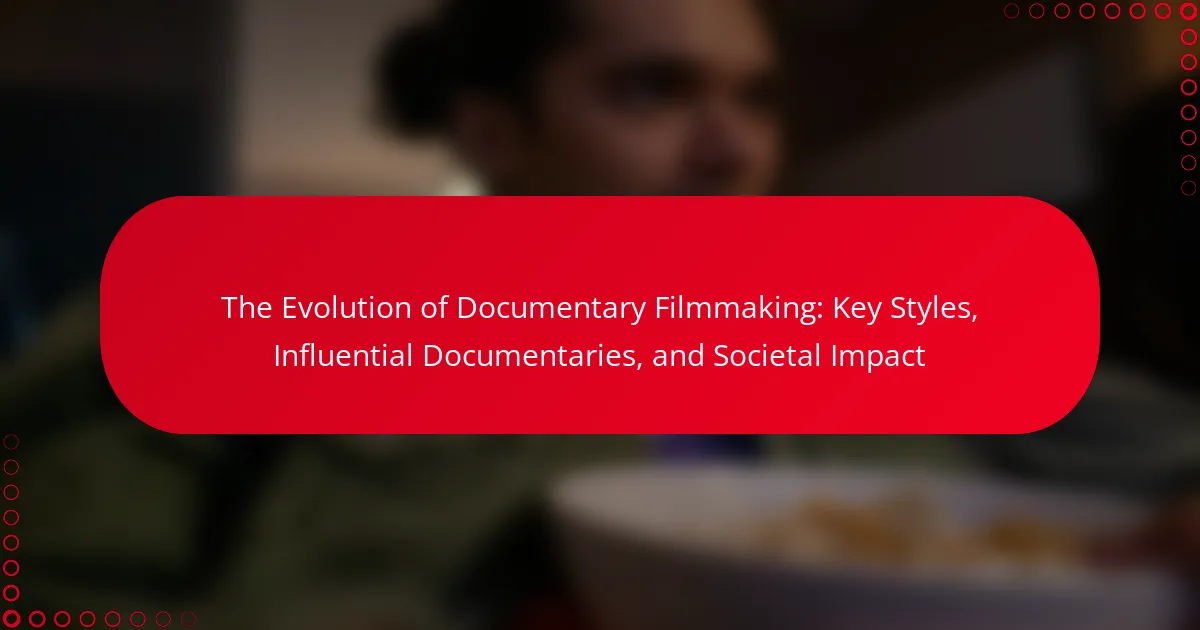Documentary filmmaking has evolved from its early roots in the late 19th century, characterized by short films that captured real-life events without narrative structure, to a diverse and impactful medium in the 21st century. Key developments include the introduction of sound in the 1920s, the rise of observational styles in the 1960s, and the democratization of filmmaking through digital technology. Documentaries today address a wide array of topics, including social justice and environmental issues, while utilizing innovative techniques such as virtual reality and interactive storytelling. Additionally, trends like short-form content and increased representation from diverse filmmakers are shaping the future of the genre, reinforcing its role in raising awareness and influencing societal change.

What is the evolution of documentary filmmaking?
Documentary filmmaking has evolved significantly since its inception in the late 19th century. Early documentaries, such as those by the Lumière brothers, focused on capturing real-life events. These films were often short and lacked narrative structure. In the 1920s, the advent of sound allowed for more complex storytelling. Filmmakers like Robert Flaherty introduced a narrative style with works such as “Nanook of the North.”
The 1960s saw the rise of direct cinema and cinéma vérité. These styles emphasized observational techniques and minimal interference from filmmakers. The 1980s and 1990s brought a surge in personal documentaries, reflecting individual perspectives and experiences.
In the 21st century, digital technology transformed documentary filmmaking. Filmmakers gained access to affordable equipment and editing software. This democratization led to a proliferation of documentaries across various platforms, including streaming services.
Today, documentaries address a wide range of topics, from social issues to environmental concerns. They continue to evolve, incorporating new technologies such as virtual reality and interactive storytelling. This evolution reflects changing societal interests and advancements in filmmaking techniques.
How has documentary filmmaking changed over the decades?
Documentary filmmaking has evolved significantly over the decades. In the early 20th century, documentaries focused on observational styles and factual reporting. The 1960s introduced participatory techniques, allowing filmmakers to engage directly with subjects. By the 1980s, personal narratives became prominent, blending the filmmaker’s perspective with factual content. The rise of digital technology in the 2000s democratized filmmaking, enabling more voices to be heard. Streaming platforms have further transformed distribution, allowing for global access to diverse stories. Today, interactive and immersive formats, such as virtual reality, are emerging, changing viewer engagement. These shifts reflect broader societal changes and advancements in technology.
What technological advancements have influenced documentary filmmaking?
Digital cameras have significantly influenced documentary filmmaking. They offer high-quality visuals with greater accessibility. This advancement allows filmmakers to capture real-life events more effectively. The introduction of lightweight, portable cameras has enabled shooting in diverse environments. Furthermore, advancements in editing software have streamlined the post-production process. Filmmakers can now edit footage quickly and efficiently. The rise of online streaming platforms has also expanded distribution options. Documentaries can reach wider audiences through digital channels. These technological changes have transformed how stories are told in documentaries.
How have audience perceptions of documentaries evolved?
Audience perceptions of documentaries have evolved significantly over the decades. Initially, documentaries were viewed as purely educational tools. They presented facts and information in a straightforward manner. Audiences often saw them as dry and lacking emotional engagement. With the rise of personal storytelling and immersive techniques, perceptions shifted. Documentaries began to resonate on emotional levels, attracting wider audiences. The influence of platforms like Netflix further democratized access to diverse documentary styles. Viewers now appreciate the artistic and narrative elements in documentaries. According to a 2020 study by the Pew Research Center, 70% of respondents reported watching documentaries for entertainment, not just education. This shift highlights a broader cultural acceptance of documentaries as valid storytelling mediums.
What are the key styles of documentary filmmaking?
The key styles of documentary filmmaking include expository, observational, participatory, reflexive, and performative. Expository documentaries focus on delivering a specific argument or perspective. They often use voice-over narration to guide the viewer. Observational documentaries capture reality without interference. They allow events to unfold naturally in front of the camera. Participatory documentaries involve the filmmaker directly interacting with the subjects. This style emphasizes the relationship between the filmmaker and the participants. Reflexive documentaries highlight the filmmaking process itself. They encourage viewers to question the nature of representation. Performative documentaries prioritize emotional engagement over factual accuracy. They often use personal narratives to convey experiences. Each style serves a unique purpose in storytelling and audience engagement.
What defines observational documentary style?
Observational documentary style is defined by its emphasis on capturing reality without interference. This style aims to present subjects in their natural environment. Filmmakers typically avoid narration and interviews. Instead, they allow events to unfold organically. The camera serves as a passive observer. This approach encourages authenticity and spontaneity. Notable examples include “Salesman” (1969) and “The War Room” (1993). These films illustrate the effectiveness of observational techniques in storytelling.
How does participatory documentary differ from other styles?
Participatory documentary differs from other styles by actively involving subjects in the filmmaking process. This style emphasizes collaboration between filmmakers and participants. Unlike traditional documentaries, which often maintain a more observational or expository approach, participatory documentaries encourage subjects to express their perspectives. This results in a more dynamic narrative that reflects the voices of those being documented.
For example, in participatory documentaries, filmmakers may conduct interviews that allow subjects to guide the conversation. This method fosters a sense of ownership and authenticity. Additionally, participatory documentaries often address social issues by highlighting the experiences of marginalized communities. This approach contrasts with styles that may prioritize the filmmaker’s viewpoint or a detached narrative. Overall, participatory documentary creates a dialogue between filmmakers and subjects, enhancing the storytelling experience.
What is the significance of expository documentary style?
Expository documentary style is significant for its ability to inform and educate audiences. This style often employs a clear narrative structure and authoritative voice-over narration. It presents facts and arguments to convey a specific message or viewpoint. Expository documentaries aim to clarify complex subjects for viewers. They often use visual aids, such as graphs and archival footage, to support their claims. This style has been influential in shaping public understanding of various issues, such as social justice and environmental concerns. Historically, films like “The Fog of War” exemplify this approach by providing insights into political events. The effectiveness of expository documentaries lies in their persuasive ability to engage viewers intellectually.
Why are influential documentaries important in the evolution of the genre?
Influential documentaries are crucial in the evolution of the genre because they set new standards and push creative boundaries. They often introduce innovative storytelling techniques that inspire future filmmakers. For example, “The Thin Blue Line” by Errol Morris redefined documentary narrative structure through its use of reenactments. This film not only changed how stories could be told but also had real-world implications, influencing legal outcomes. Documentaries like “Super Size Me” brought attention to health issues and sparked national debates. Such influential works drive the genre forward by blending entertainment with education and advocacy. They create cultural conversations and inspire social change, demonstrating the power of visual storytelling in shaping public perception.
Which documentaries have had the most impact on society?
“Documentaries that have had the most impact on society include ‘An Inconvenient Truth,’ ‘Blackfish,’ and ’13th.’ ‘An Inconvenient Truth’ raised awareness about climate change, influencing public policy and personal behaviors. It won an Academy Award and sparked global discussions. ‘Blackfish’ highlighted the ethical issues of keeping orcas in captivity. This documentary led to significant changes in public perception and corporate practices. ’13th’ examined racial inequality in the United States, prompting nationwide conversations about systemic racism and criminal justice reform. Each of these documentaries has driven social change and influenced public opinion.”
How do influential documentaries shape public opinion?
Influential documentaries shape public opinion by presenting compelling narratives and factual evidence. They often highlight social issues, prompting viewers to reconsider their perspectives. Documentaries like “An Inconvenient Truth” raised awareness about climate change, influencing policy discussions. Research indicates that 70% of viewers reported changed opinions after watching impactful documentaries. These films can mobilize communities and inspire activism, demonstrating their power in shaping societal norms. By using emotional storytelling and credible sources, documentaries resonate with audiences and foster critical dialogue.

What societal impacts have resulted from documentary filmmaking?
Documentary filmmaking has significantly influenced societal awareness and change. It raises awareness about social issues, such as poverty, racism, and environmental concerns. Documentaries like “An Inconvenient Truth” have mobilized public opinion on climate change. They often provide a platform for marginalized voices, promoting social justice. Furthermore, documentaries can shape public policy by informing lawmakers and citizens alike. Research indicates that documentaries can alter viewers’ perceptions and encourage activism. A study by the University of California found that exposure to social issue documentaries increased participants’ likelihood to engage in community service. Overall, documentary filmmaking serves as a powerful tool for education and social transformation.
How do documentaries raise awareness about social issues?
Documentaries raise awareness about social issues by presenting factual narratives that highlight specific problems. They use visual storytelling to engage viewers emotionally and intellectually. This format allows for a deeper understanding of complex topics. Documentaries often include interviews with affected individuals and experts. This firsthand perspective adds authenticity to the narrative. Statistics and data are frequently presented to support claims. For instance, “13th,” directed by Ava DuVernay, illustrates systemic racism in the U.S. through historical context and statistics. By combining personal stories with factual evidence, documentaries foster empathy and drive public discourse. They can inspire action and advocacy by mobilizing viewers to engage with the issues presented.
What role do documentaries play in advocacy and activism?
Documentaries serve as powerful tools for advocacy and activism. They raise awareness about social issues and injustices. By presenting factual narratives, documentaries inform the public and stimulate discussions. They often highlight marginalized voices and perspectives. This can lead to increased empathy and understanding among viewers. Documentaries can motivate audiences to take action, whether through donations, protests, or policy changes. For instance, films like “An Inconvenient Truth” significantly impacted climate change awareness. Such films can influence public opinion and drive legislative change, showcasing their effectiveness in advocacy.
How can documentaries influence policy changes?
Documentaries can influence policy changes by raising awareness and shaping public opinion. They present factual narratives that highlight social issues and injustices. For example, the documentary “Blackfish” led to significant changes in policies regarding orca captivity. This film illustrated the ethical concerns surrounding marine parks. As a result, SeaWorld faced public backlash and altered its practices. Documentaries often mobilize grassroots movements, prompting citizens to advocate for change. Research shows that visual storytelling can be more persuasive than traditional media. Documentaries provide a platform for marginalized voices, influencing policymakers to address their concerns.
In what ways do documentaries contribute to cultural understanding?
Documentaries contribute to cultural understanding by presenting diverse perspectives and narratives. They showcase the lives, traditions, and challenges of various communities. This exposure fosters empathy and awareness among viewers. For instance, documentaries like “13th” highlight systemic racism in the U.S. They provide historical context and personal stories, making complex issues more relatable. Additionally, documentaries often include interviews with cultural figures, enhancing authenticity. By depicting real-life experiences, they challenge stereotypes and promote dialogue. The impact of documentaries can be seen in educational settings, where they serve as tools for discussion and critical thinking. Overall, documentaries play a vital role in bridging cultural gaps and promoting global awareness.
How do documentaries promote diverse perspectives?
Documentaries promote diverse perspectives by showcasing various cultural, social, and political viewpoints. They often feature interviews with individuals from different backgrounds. This format allows for a multitude of voices to be heard. Documentaries can highlight underrepresented communities and issues. For example, films like “13th” by Ava DuVernay explore systemic racism in the United States. Such works provide historical context and personal narratives. This approach fosters empathy and understanding among viewers. Research indicates that exposure to diverse stories can challenge stereotypes and broaden perspectives.
What is the impact of documentaries on historical narratives?
Documentaries significantly shape historical narratives by presenting factual accounts and interpretations of events. They influence public perception by framing historical context and highlighting specific perspectives. For instance, Ken Burns’ “The Civil War” redefined understanding of the American Civil War through personal stories and archival footage. Documentaries often challenge dominant narratives, as seen in “13th,” which examines systemic racism in the U.S. They serve as educational tools, making history accessible to wider audiences. Additionally, documentaries can evoke emotional responses, fostering empathy and understanding of historical events. Their impact is evident in how they can lead to renewed discussions and re-evaluations of historical facts and figures.

What are the future trends in documentary filmmaking?
Future trends in documentary filmmaking include increased use of virtual reality and interactive storytelling. These technologies enhance viewer engagement by creating immersive experiences. Additionally, there is a growing focus on social justice themes. Documentaries are increasingly addressing pressing global issues, such as climate change and inequality.
Another trend is the rise of short-form content. Platforms like social media are popularizing brief documentaries that reach wider audiences. Furthermore, collaborative filmmaking is becoming more prevalent. Filmmakers are partnering with communities to tell authentic stories.
Diversity in representation is also a significant trend. More filmmakers from underrepresented backgrounds are gaining visibility. This shift enriches the narrative landscape of documentaries.
Finally, the integration of data and analytics is shaping content creation. Filmmakers are using audience insights to tailor their projects effectively. These trends demonstrate the evolving landscape of documentary filmmaking.
How is digital technology shaping the future of documentaries?
Digital technology is significantly shaping the future of documentaries through enhanced accessibility and production capabilities. Filmmakers can now create high-quality content using affordable equipment, such as smartphones and digital cameras. This democratization allows more voices to be heard in the documentary space. Advanced editing software simplifies the post-production process, enabling quicker turnaround times. Streaming platforms provide broader distribution channels, reaching global audiences instantly. Data analytics tools help creators understand viewer preferences, guiding content creation. Furthermore, virtual reality and interactive formats are emerging, offering immersive experiences. This evolution reflects a shift towards more engaging and diverse storytelling methods in documentaries.
What role do streaming platforms play in documentary distribution?
Streaming platforms significantly enhance documentary distribution. They provide filmmakers with wider access to global audiences. Traditional distribution methods often limit reach to specific regions. Streaming services can host a vast library of content. This allows viewers to discover diverse documentaries easily. Platforms like Netflix and Amazon Prime have invested heavily in original documentaries. Their financial support enables filmmakers to create more ambitious projects. Additionally, streaming platforms offer data insights on viewer preferences. This information helps producers tailor content to audience interests. Overall, streaming platforms revolutionize how documentaries are distributed and consumed.
How are interactive documentaries changing viewer engagement?
Interactive documentaries are transforming viewer engagement by allowing audiences to actively participate in the storytelling process. This format shifts viewers from passive observers to active participants, enhancing their emotional connection to the content. Users can make choices that influence the narrative direction, creating a personalized experience. Research indicates that interactive elements can increase retention and comprehension of information. For instance, a study by the University of Southern California found that participants remembered 30% more information from interactive formats compared to traditional documentaries. This engagement fosters a sense of agency and investment in the subject matter. As a result, interactive documentaries are redefining how stories are told and experienced.
What best practices can filmmakers follow in documentary production?
Filmmakers should prioritize thorough research in documentary production. This involves gathering accurate information about the subject matter. Conducting interviews with experts enhances credibility. Filmmakers must also establish a clear narrative structure. A well-defined storyline keeps the audience engaged. Utilizing high-quality equipment is essential for visual and audio clarity. Good lighting and sound capture improve overall production quality. Filmmakers should also be adaptable during filming. Unforeseen events can lead to valuable content. Lastly, obtaining proper permissions and releases is crucial. This ensures legal compliance and protects the filmmakers’ work.
How can filmmakers effectively research their documentary topics?
Filmmakers can effectively research their documentary topics by utilizing multiple sources and methods. They should start with academic journals and books related to their subject matter. These sources provide in-depth analysis and historical context. Filmmakers can also conduct interviews with experts in the field. This firsthand information can offer unique insights and perspectives.
Online databases and archives are valuable for accessing primary sources and historical documents. Websites like the Library of Congress and academic institutions often house extensive collections. Additionally, filmmakers should engage with communities related to their topic. This can facilitate understanding of lived experiences and local narratives.
Attending relevant conferences and workshops can enhance knowledge and networking opportunities. Filmmakers can also analyze existing documentaries for style and content inspiration. This helps in identifying gaps in current narratives. Overall, a combination of scholarly research, expert interviews, community engagement, and analysis of existing works leads to thorough and effective research.
What ethical considerations should be taken into account in documentary filmmaking?
Ethical considerations in documentary filmmaking include truthfulness, consent, and representation. Filmmakers must ensure accuracy in their portrayal of events and subjects. Misrepresentation can lead to misinformation and harm to individuals or communities. Obtaining informed consent from participants is crucial for ethical integrity. This ensures that subjects understand how their stories will be used. Respect for privacy is also essential, especially for vulnerable populations. Filmmakers should avoid exploiting subjects for entertainment. Transparency about funding sources and potential biases is necessary for credibility. Ethical documentary filmmaking fosters trust between filmmakers and audiences.
The main entity of the article is documentary filmmaking, which has undergone significant evolution since its inception in the late 19th century. The article outlines the key styles of documentary filmmaking, including expository, observational, participatory, reflexive, and performative approaches, and highlights influential documentaries that have shaped public opinion and societal change. It also examines technological advancements, audience perceptions, and the role of documentaries in advocacy and activism. Additionally, the article discusses future trends in documentary filmmaking, such as the rise of digital technology, interactive formats, and the impact of streaming platforms on distribution. Overall, it provides a comprehensive overview of how documentary filmmaking has transformed over time and its ongoing relevance in addressing social issues.
